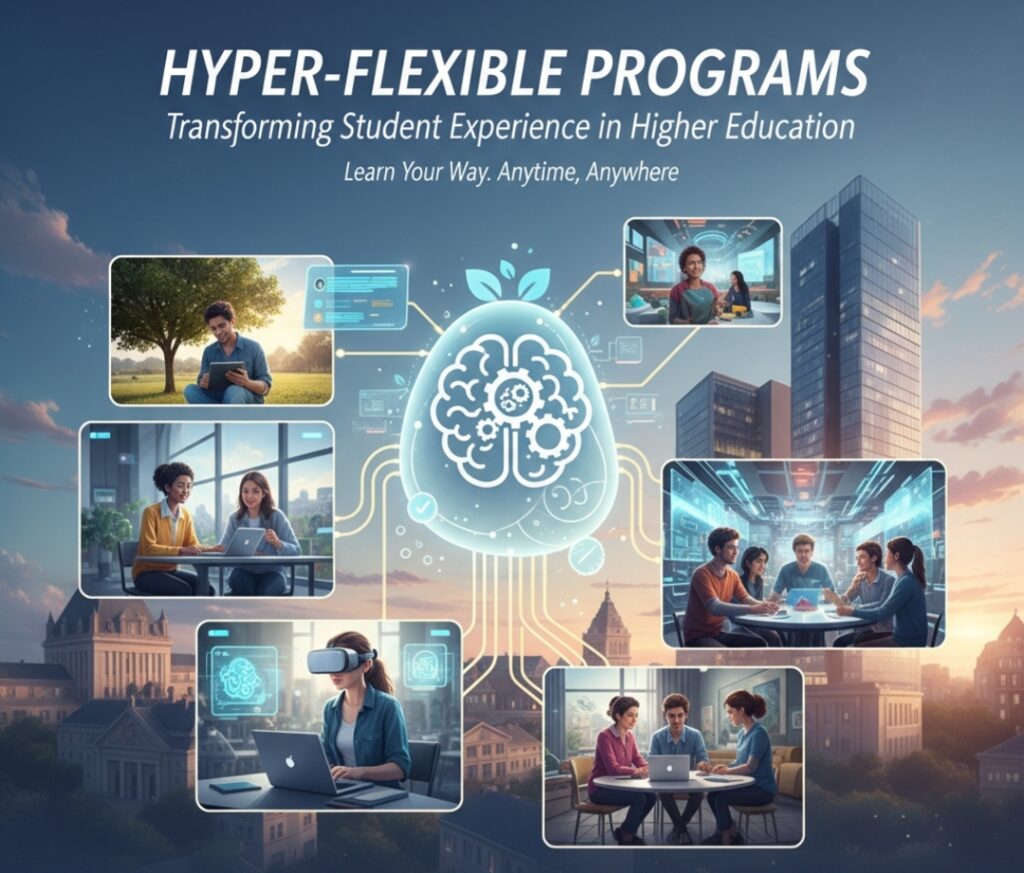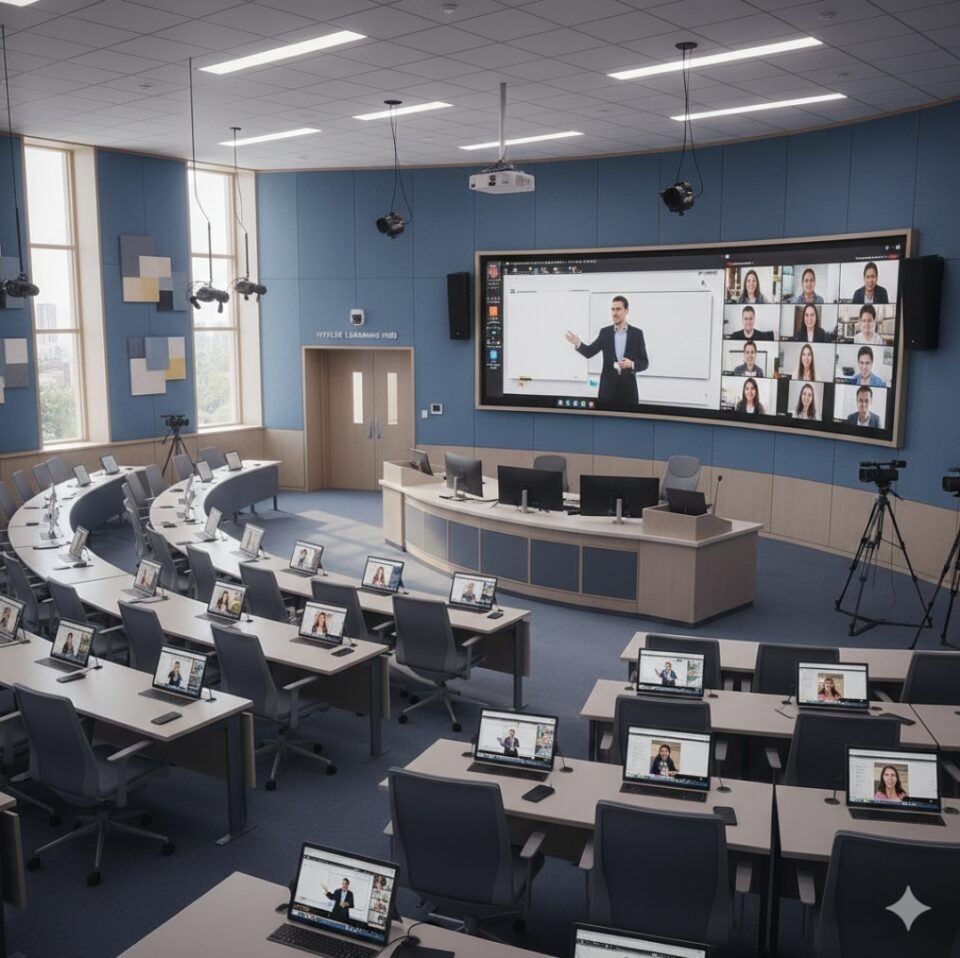Hyper-Flexible Programs: Redefining Student Experience in Higher Education
Your institution just lost another promising student. Not because of poor academics or lack of resources. The reason? Rigid schedules that couldn’t accommodate a working parent juggling career, family, and education dreams. Now, let’s look at Hyper-Flexible Programs.
This scenario plays out thousands of times across campuses worldwide. Traditional higher education models are breaking under the weight of modern realities. Students today aren’t asking for easier paths—they’re demanding smarter ones that fit their complex lives.
Enter hyper-flexible programs. These aren’t just tweaked versions of online courses. They represent a fundamental reimagining of how universities deliver education in 2025 and beyond.
The Student Experience Crisis Nobody’s Talking About
Today’s learners face unprecedented pressures. Data reveals a stark reality: 71% of students prefer hybrid learning models over traditional classroom settings. Gen Z students openly reject rigid academic structures, demanding sustainable learning approaches that prioritize mental health alongside academic achievement.
The numbers tell a compelling story. Enrollment in hybrid flexible programs increased from 152 to 194 students on average in 2022 alone. This isn’t a temporary shift—it’s a permanent transformation in student expectations.
Working professionals represent a massive untapped market. Many hold full-time jobs while pursuing degrees. Traditional 9-to-5 class schedules simply don’t work for them. Family responsibilities, caregiving duties, and financial pressures create barriers that rigid programs can’t overcome.
Universities continuing with one-size-fits-all approaches risk becoming obsolete. Student retention suffers when institutions fail to recognize diverse learner populations. The message is clear: adapt or watch enrollment numbers plummet.
What Makes Hyper-Flexible Programs Different
Hyper-flexible programs break free from traditional constraints. They offer unprecedented autonomy in three critical dimensions: pace, place, and pathway.
Students control their learning pace. Competency-based education allows progression based on mastery, not seat time. A student who already understands algebraic concepts can accelerate forward. Another student needing more support can take additional time without penalty or stigma.
Location flexibility eliminates geographic barriers. HyFlex classrooms enable students to choose between in-person attendance, synchronous online participation, or asynchronous engagement—sometimes changing modes week by week based on life demands.
Personalized pathways recognize that learners bring different strengths and goals. Digital tools create individualized learning trajectories. Arizona State University’s adaptive math courses identify knowledge gaps in real-time, serving targeted exercises that keep learners motivated and engaged.
The Australian model pushes boundaries even further. Charles Darwin University’s programs allow students to start anytime with no fixed terms. They simply have a set completion period—typically five years for a master’s degree—with no fixed assessment deadlines or group assignments.
The Data Behind Flexible Learning Success
Evidence supporting hyper-flexible approaches continues mounting. Arizona State University achieved remarkable results implementing adaptive courseware combined with active learning pedagogy.
College Algebra courses showed a 17-point gain in student success rates. In 2012, only 57% of students earned grades of C or better. By 2019, that figure jumped to 85%. The adaptive system identified struggling students early and provided personalized support.
Microeconomics outcomes proved equally impressive. Students receiving A grades on first midterm exams increased from 15% to 47%. D grades dropped from 21% to 3%. E grades fell from 17% to 3%. Final course grades showed 85% of students achieving C or higher compared to 73% previously.
Introduction to Biology courses sustained significant gains over four consecutive years. Spring 2015 saw 72% of students earning C or better. That percentage climbed to 91% in 2016 and remained steady through 2019 at 90%.
Research examining five flexibility dimensions—deadlines, modality, assessment type, grading and weighting, and course correspondence—revealed strong alignment between student and educator preferences. Both groups favored collaborative deadline setting, non-timed assessments, and more frequent lower-weighted tasks.
Students showed increased preference for hybrid learning despite general in-person format preference. This underscores the value placed on flexibility and adaptability in educational experiences.
Four Pillars of Successful Hyper-Flexible Implementation
Brian Beatty, pioneer of HyFlex teaching since 2006, identified four essential pillars for successful flexible programs.
Learner Choice forms the foundation. Students need relevant alternate engagement modes. They should choose between daily, weekly, or topic-based participation without penalty.
Equivalency ensures fairness. Learning activities across different participation modes must produce equivalent results. Online students shouldn’t receive inferior experiences compared to in-person attendees.
Reusability maximizes efficiency. Artifacts from learning activities become learning objects for all students regardless of participation mode. Recorded lectures, discussion summaries, and collaborative projects serve multiple audiences.
Accessibility removes barriers. Students need equal access to all engagement means. This requires robust technical infrastructure, digital literacy support, and accommodation for diverse needs including disabilities and socioeconomic challenges.
The Human Element: Support Systems That Matter
Technology alone doesn’t create successful flexible programs. Human support structures determine whether students thrive or struggle.
Mentoring programs prove particularly valuable. Students receiving one-on-one mentoring demonstrate improved learning outcomes and retention. Mentors help students develop effective study plans, overcome obstacles, and maintain motivation during challenging periods.
Faculty training becomes critical. Instructors need professional development in online teaching, technology integration, and pedagogical approaches suitable for flexible environments. Student engagement strategies differ significantly between traditional and flexible formats.
Academic support services require redesign. Prompt feedback, high-quality course design, and robust lecturer support all contribute significantly to student retention in flexible programs. Traditional office hours don’t work when students engage asynchronously across multiple time zones.
Financial aid offices must adapt communication strategies. Transparent information delivery helps students navigate payment complexities while managing work and family responsibilities. Flexible payment options reduce financial stress that drives dropout decisions.
Mental health support deserves special attention. Flexible learners often juggle competing demands that create stress. Institutions should provide extended counseling hours, virtual support options, and academic accommodations for students experiencing mental health challenges. Offering deadline flexibility and alternative assessment spaces can make crucial differences.

Overcoming Implementation Barriers
Despite proven benefits, institutions face significant obstacles implementing hyper-flexible programs.
Departmental resistance slows adoption. Faculty members accustomed to traditional teaching methods may question flexible approaches. Arizona State University discovered that momentum stalled when untrained instructors rotated through courses previously taught by trained faculty.
Technology infrastructure requires substantial investment. HyFlex classrooms need quality cameras, microphones, cloud-based videoconferencing platforms, and learning management systems. Schools must balance budget constraints against infrastructure needs.
Courseware content challenges emerge frequently. Customizing adaptive content adds complexity and delays scaling. Faculty preferences vary across disciplines—biology instructors favor small group work while psychology departments utilize large active learning lecture halls.
Workload concerns affect faculty wellbeing. Setting up flexible programs requires additional time and effort. Teachers report increased cognitive load delivering HyFlex courses compared to traditional formats. Institutions must recognize this burden and provide adequate support including possible teaching load reductions.
Assessment integrity becomes more complex. Ensuring academic honesty across multiple delivery modes requires innovative proctoring solutions, varied assessment types, and clear academic integrity policies that work across formats.
Measuring Success: Metrics That Matter
Institutions need clear success indicators for flexible programs. Traditional metrics often fail to capture full impact.
Retention rates provide primary evidence. Compare completion rates between flexible and traditional programs. Track dropout timing—students leaving after first semester signal different issues than those departing later.
Student satisfaction surveys reveal qualitative insights. Ask specific questions about flexibility benefits, support adequacy, and technology effectiveness. Open-ended responses often uncover unexpected challenges or opportunities.
Time-to-degree completion offers important data. Hyper-flexible programs should reduce completion time for capable students while allowing others more time without penalty.
Learning outcomes assessment ensures quality maintenance. Compare exam scores, project quality, and skill demonstrations across delivery modes. Equivalency requires continuous monitoring and adjustment.
Post-graduation success tracking validates program effectiveness. Employment rates, graduate school acceptance, career advancement, and employer satisfaction all indicate whether flexible programs deliver real-world value.
Demographic impact analysis ensures equity. Examine which student populations benefit most from flexibility. Identify and address any groups experiencing disproportionate challenges.
Looking Forward: The Future of Hyper-Flexible Education
Emerging trends suggest hyper-flexible programs will continue evolving rapidly.
Hyper-personalized AI tutors will adapt to individual learning habits and emotional states. Systems sensing student frustration can adjust difficulty levels or teaching approaches in real-time.
Virtual reality integration promises immersive customized learning experiences. Students could explore historical events, conduct virtual laboratory experiments, or practice complex procedures in safe simulated environments.
Micro-credentials and competency-based certifications will proliferate. Students can earn stackable credentials aligned with workforce needs without committing to full degree programs initially.
Lifelong adaptive learning systems will support education at every life stage. The same flexible infrastructure serving undergraduates can accommodate mid-career professionals and retirees pursuing personal enrichment.
Blockchain technology may revolutionize credential verification and transfer. Students could accumulate learning achievements across multiple institutions, creating comprehensive portable records.
Global collaboration opportunities will expand. Time zone differences become advantages when students participate asynchronously, bringing diverse international perspectives into virtual classrooms.
Practical Recommendations for CX and EX Leaders
Educational institutions ready to implement hyper-flexible programs should consider these actionable steps.
Start with pilot programs. Choose one or two courses with high enrollment and supportive faculty. Early successes build confidence and momentum for broader adoption.
Invest heavily in faculty development. Provide comprehensive training in flexible pedagogy, technology tools, and student engagement strategies. Create communities of practice where experienced instructors mentor newcomers.
Build cross-functional implementation teams. Include representatives from academic affairs, IT, student services, financial aid, and registrar offices. Flexibility requires coordination across traditional silos.
Establish clear communication channels. Students need transparent information about program structure, technology requirements, support resources, and expectations. Regular check-ins prevent small issues from becoming dropout triggers.
Create robust support infrastructure. Extend student services hours, offer virtual advising, provide technical help desks, and ensure mental health resources accommodate flexible learners’ schedules.
Develop flexible assessment methods. Move beyond traditional timed exams. Incorporate projects, portfolios, presentations, and competency demonstrations that showcase learning across participation modes.
Monitor and iterate continuously. Collect data systematically, survey stakeholders regularly, and adjust based on evidence. Flexibility applies to program design as much as student participation.
Address equity concerns proactively. Ensure all students have necessary technology access. Provide loaner equipment, internet hotspots, and alternative participation options for students facing resource constraints.
Celebrate and share successes. Publicize positive outcomes, student testimonials, and faculty innovations. Build institutional culture that values flexible learning as rigorous and valuable.
Think long-term sustainability. Avoid treating flexible programs as temporary pandemic solutions. Build permanent infrastructure, policies, and cultural changes that position institutions for future success.
The Bottom Line
Hyper-flexible programs represent more than incremental improvements to higher education. They fundamentally reimagine the student experience around learner needs rather than institutional convenience.
The evidence is overwhelming. Students want flexibility. They need flexibility. Institutions providing it see improved retention, higher satisfaction, and better learning outcomes.
The question isn’t whether to adopt hyper-flexible approaches. It’s how quickly your institution can implement them before competitors capture students you’re losing to rigid structures.
Traditional higher education served past generations well. But modern learners face different realities requiring different solutions. Hyper-flexible programs meet students where they are—literally and figuratively—creating pathways to success that work with life, not against it.
The future of education is flexible. The institutions thriving tomorrow are building that flexibility today.

